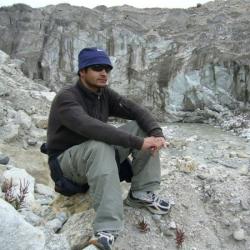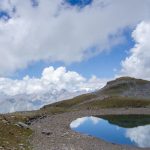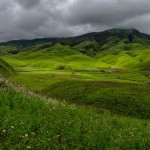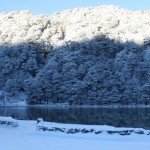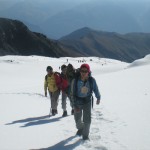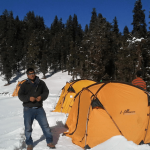Subscribe Now
Get the Latest Updates From Trekking In India Blog8 Dependable Safety Tips for Trekkers
Posted on Fri, 13 Feb 2015 07:40:41 by Arun Joshi

Trekking has gained immense popularity as an adventure sport in recent years. Trekking is a rewarding as well as punishing adventurous activity that tests your physical endurance and guts. Certainly, there will be some challenges such as fatigue and dehydration (especially, if you are trekking in summers) that you may encounter on your trekking tour. But these problems are expected and manageable; the situation gets tricky when you encounter some unexpected difficulties. Heavy downpours, a lurking wildlife, a surprise whiteout, or a wobbly rock at the edge of a cliff may pose some serious trouble in front of you. Follow these safety tips to escape any kind of danger on your next trekking tour:
Get Updated About the Weather Forecast of the Area:
Checking the weather forecast before you head out is very important. It will help you make preparations according to the weather. If you are travelling in winters, be sure that winds will be cooler at higher elevations. Also, check if there are forecasts of thunderstorms, snowfall, heavy rains etc in coming days. Avoid trekking in these days if there is any such update. Otherwise, make necessary preparations according to the forecast.
Don’t Trek Alone:
Buddy system always works. When you are trekking in a group, make sure that you don’t walk so fast that the slowest members of the group are left behind. Also, take care of everyone in the group. Make sure that everyone in your group has enough physical ability to successfully complete the trek. Another benefit of trekking in a group is that you have someone with you who can help in case of any emergency. Inform someone about your trekking schedule when you are leaving.
Keep Your Trekking Essentials Handy:
- Now, this is very important. Trekking essentials include your trekking gear, emergency kit and eatables.
- Always carry a rain coat even if there are no forecasts of rain. Weather changes dramatically at higher elevations and you should be ready for that. A good pair of footwear will make a lot of difference; carry boots which can support the ankles. Also, wear bright clothes.
- A pocket-torch or headlamp should be with you as it gets dark early on the mountains. If you don’t have enough source of light, you may lose your trail.
- A Compass or maps should be with you.
- A basic first-aid kit is necessary; also learn how to administer first aid. This will help you in dealing with short injuries.
- Keep a matchstick with you in case you need to light a fire. Fire will help you to stay warm as well as it will keep wild animals away.
- Carry a whistle; this will help you to meet other trekking members in case you get off the trail.
- Carry eatables which can help you in getting instant energy. Fruits, granola, peanut butter, bagels, power bars, fruit bars will work for you while on a trekking expedition. Carry lots of water in order to avoid dehydration.
Don’t Rely Heavily on Mobile-Phones:
Mobile phones may not work in the wilderness. Depending too much on them may leave you disappointed.But if you are lucky enough to get network signal on the mountains, inform someone with all the details of the location.
Don’t Leave the Designated Trail:
Never, ever leave the specified trail. If you are travelling and are forced to hold up due to fatigue, make sure that you have someone who knows the trail well staying back with you; otherwise you may get lost and might have a difficult time reuniting with the other members. Looking for short-cuts might get you into trouble. Be sure to follow the right path for a successful trek.
Pack Light:
Make sure that you don’t carry unnecessary stuff. Keep your backpack as light as possible. Carrying a light backpack will help you preserve energy for the activities ahead. But don’t overlook the essential stuff.
Learn How to Survive an Animal Attack:
Learn the basics of how to escape an animal attack in case of a mishap. A good trekker should also have the knowledge of understanding animal behavior. Also wear full sleeve shirt and full pant especially at night to prevent insect bite. Follow the instructions given by the guide, if there is one accompanying you.
What if You are Lost?
You followed all the safety tips but you were not lucky enough to successfully complete your trek and you lost your path. Now what to do?
- Make a shelter for yourself so that wild animals can’t attack you.
- Keep yourself dry.
- Blow the whistle so that someone can hear you.
- If you see helicopters above your heads searching for you, stand at an open place so that you can be easily seen.
Clincher:
Trekking may be a truly rewarding experience if done with complete preparation. Before you head for trekking, you should also learn about altitude sickness. You should also take care of personal hygiene to make sure that you don’t fall sick in the mountains. Hope for the best but stay prepared for the worst, as a trekking tour may throw unexpected challenges.
Also Check out:
- Popular Trekking Trails in Ladakh
- Popular Trekking Trails in Sikkim
- Popular Trekking Places in Garhwal
- Popular Trekking Places in Kumaon
- Popular Trekking Destinations in Himachal Pradesh
- Jammu & Kashmir Trekking Destinations




